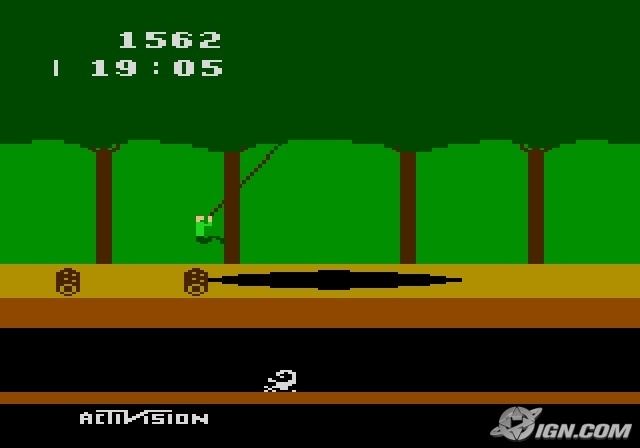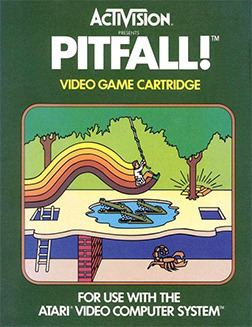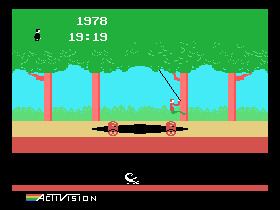8 /10 1 Votes
| 4/5 Google Play Initial release date 1982 Genre Platform game | |||||||||||||||||||||||||||||||||
 | ||||||||||||||||||||||||||||||||||
Publishers Activision, Activision Blizzard, Microsoft Studios, Pony Canyon, Home Entertainment Suppliers, Al Alamiah Similar David Crane games, Platform games | ||||||||||||||||||||||||||||||||||
Atari 2600 longplay 004 pitfall
Pitfall! is a platform video game designed by David Crane and released by Activision for the Atari 2600 in 1982. In the game, the player controls Pitfall Harry, and is tasked with navigating a jungle and collecting treasures while avoiding obstacles and hazards, with limited time to complete the game.
Contents
- Atari 2600 longplay 004 pitfall
- Gameplay
- History and development
- Release
- Reception
- Sequels and ports
- Legacy
- Popular culture
- References

Pitfall! received very positive reviews upon release, and is one of the best-selling games made for the Atari 2600, with over 4 million copies sold. It was the top video game on the Billboard charts for more than a year, and inspired numerous sequels and ports across a variety of gaming consoles. It is widely viewed as helping define the side-scrolling platformer genre.

Gameplay

The player must maneuver a character (Pitfall Harry) through a maze-like jungle in an attempt to recover 32 treasures in a 20-minute time period. Along the way, he must negotiate numerous hazards, including pits, quicksand, rolling logs, fire, rattlesnakes, scorpions, and crocodiles. Harry may jump over or otherwise avoid these obstacles by climbing, running, or swinging on vines. Treasure includes bags of money, gold and silver bars, and diamond rings, which range in value from 2000 to 5000 points in 1000 point increments. There are eight of each treasure type, with 32 in total. A perfect score of 114,000 is achieved by claiming all 32 treasures without losing any points. Points are deducted by either falling in a hole (100 points) or touching logs; point loss depends on how long contact is made with the log. Under the jungle there is a tunnel which Harry can access through ladders found at various points. Traveling though the tunnel moves forward three screens at a time, which is necessary in order to collect all the treasures within the time limit. However, the tunnels are filled with dead-ends blocked by brick walls, forcing the player to return to the surface at one of the ladders, and try to find a way around again, thus wasting time. The tunnels also contain scorpions. The player loses a life if Harry comes in contact with any obstacle (except logs) or falls into a tar pit, quicksand, waterhole, or mouth of a crocodile. The game ends when either all 32 treasures have been collected, all three lives have been lost, or the time has run out.
History and development

Pitfall! was created by David Crane, a programmer who worked for Activision in the early 1980s. In a November 2003 interview with Edge he described how in 1979 he had developed the technology to display a realistic running man and in 1982 was searching for a suitable game in which to use it:

The game's technical achievements included non-flickering, multicolored, animated sprites on a system with notoriously primitive graphics hardware. Innovative techniques were used to keep the code space within the 4k limit, including a polynomial counter to create 256 screens within 50 bytes of code. The swinging vines are created by repeatedly displaying the Atari's one-pixel "ball" sprite at different offsets.
Release

Several ports were made for computer systems, such as the MSX, Commodore 64, Atari 800, as well as for home consoles, such as ColecoVision and Intellivision.
Versions of Pitfall! were ported to other home computers under different names around 1983. One version was 'Trapfall' by Ken Kalish through Tom Mix Software for the Tandy Coco, which was licensed and sold as part of the Cuthbert series on the Dragon 32 as Cuthbert in the Jungle by Microdeal in the United Kingdom. This version was then re-ported back to computers like the Commodore 64.
When Pitfall! was originally sold, anyone who scored above 20,000 points could send Activision a picture of his or her television screen to receive a Pitfall Harry Explorer Club patch. The television commercial for Pitfall featured then-child actor Jack Black at age 13 in his first TV role.
Reception
Possibly because of the great success of Raiders of the Lost Ark, Pitfall! for the Atari 2600 was the best-selling home video game of 1982 and the first quarter of 1983, and the No. 1 video game on Billboard for 64 weeks in a row. It was much more successful than rival E.T., the license for which Atari had paid $21 million. Arcade Express reviewed the Atari 2600 version of Pitfall! on August 30, 1982, shortly before release, stating that it "may well be the best adventure game yet produced for the VCS" and giving it a score of 8 out of 10. The same version was awarded "Best Adventure Video Game" at the 4th annual Arkie Awards. and Electronic Games in June 1983 praised its "superb graphics and varied play-action".
Video Games in March 1983 criticized Activision for not enhancing the Intellivision version's graphics: "We all know you can do more with graphics on Intellivision than on the VCS. So why no improvements in Pitfall?"
In 2013 Entertainment Weekly listed Pitfall! as one of the ten best Atari 2600 games.
Sequels and ports
Crane produced an Atari 2600 sequel, Pitfall II: Lost Caverns, in 1983.
The Pitfall! series appeared on the Nintendo Entertainment System in November 1987, in the form of Super Pitfall which is a reworking of Pitfall II: Lost Caverns.
In 1985, Activision licensed Pitfall! to Sega, who made an arcade version of Lost Caverns. The game was thoroughly remade with a first level resembling the original Pitfall!, a second level resembling the caverns of Pitfall II, and later levels that were completely original. This version was adapted for the SG-1000. Pitfall! was produced for the Commodore 64 and Apple II home computers using Garry Kitchen's GameMaker, primarily as a demonstration of the game building software.
Pitfall: The Mayan Adventure, which was closer to 16-bit platformers than to the Atari 2600 games, made its debut on the Super Nintendo Entertainment System and Mega Drive/Genesis in 1994. It later appeared on the Sega CD and Sega 32X consoles. The game was ported to the Windows 95 operating system and the Atari Jaguar in 1995. Its most recent re-release was in 2001, on the Game Boy Advance. The Mayan Adventure includes the original Pitfall! game.
In 1998, Pitfall 3D: Beyond the Jungle, featuring the voice of Bruce Campbell as Pitfall Harry Jr., was released for the PlayStation and Game Boy Color (without the 3D designation). In 2004, a fourth sequel was released for PlayStation 2, GameCube, and Xbox, Pitfall: The Lost Expedition. The game includes both the original Pitfall! and Pitfall II games. A port of The Lost Expedition, Pitfall: The Big Adventure, was released for the Wii on September 23, 2008.
In May, 2010, Pitfall! was released on Microsoft's Game Room service for its Xbox 360 console and for Windows-based PCs. It was also ported as both a Game Room and Xbox Live title on Windows Phone in February 2011.
On August 9, 2012, Activision released Pitfall! for iOS, on the iPhone, iPad, and iPod Touch. On December 21, Activision released Pitfall! for Android as a free app. This version of the game departed from the 2D graphics seen in the original, and instead used 3D graphics. Gameplay was also altered; the game was an endless runner in the style of Temple Run.
That same month, Crane announced a Kickstarter for Jungleventure, a spiritual successor to the original games. His goal was to raise US$900,000. The project failed to reach its target, raising only $31,207. Crane said the reason was because people thought he was asking for too much money and that "everyone turned against me as soon as they saw [the price]."
Legacy
Pitfall! is generally viewed as having creating the side-scrolling platforming genre; although it did not scroll, it had all the features of such games, such as the ability to travel up and down on multiple levels of play. The game was also much longer than other Atari 2600 games of its time, which typically lasted only a few minutes. This was due to the majority of such games being ports of arcade games, where short play time encouraged players to spend more money.
Pitfall! is considered one of the most influential games on the Atari 2600 system; it introduced the jungle setting to video games, something that the Tomb Raider series copied later. Many of the game mechanics were used in games like Prince of Persia.
